Mobile GPU Faceoff: AMD Dynamic Switchable Graphics vs. NVIDIA Optimus Technology
by Jarred Walton on September 20, 2011 6:40 AM ESTWhat about Recent Games?
We do have one major concern with AMD’s Dynamic Switchable Graphics that we haven’t really addressed so far: drivers. Why are drivers a problem? Just like AMD’s non-dynamic switchable graphics, you’re stuck waiting for your laptop OEM to release new drivers, as AMD’s mobile reference drivers are only for discrete GPUs (and even then, not all OEMs participate, Sony and Toshiba being two prime examples). The drivers for switchable graphics consist of a proxy driver that intercepts calls and determines which GPU should receive the request, Intel’s IGP driver, and AMD’s GPU driver. AMD informed us that they make a new driver build available on a monthly basis for switchable graphics, but it’s up to the laptop vendors to test and validate the driver (and add in their hooks for keyboard shortcuts like LCD brightness and such) and make it available to the public. Generally speaking, this happens when a laptop is first launched, and if you’re lucky, you might get one or two more driver updates before the OEM stops worrying about an older model laptop.
So how big of a concern is this really? Our selection of gaming benchmarks consists of games that are all six months to more than a year old, so any moderately recent driver should work properly on our test suite. As we’ve already noted, there was a periodic stability issue in DiRT 2 (not consistently reproducible and perhaps related more to the game than AMD’s drivers), and there was a major rendering issue in StarCraft II at medium detail settings or higher. With our current gaming suite experiencing problems, we wanted to look at some newer titles to see if the drivers might have additional issues.
We selected six games that have all come out in the past six months. In alphabetical order, the games are Deus Ex: Human Revolution, DiRT 3, Duke Nukem Forever, Portal 2, Super Street Fighter IV: Arcade Edition, and The Witcher 2—and we’re also tossing in results from Enemy Territory: Quake Wars just for fun (an OpenGL game). Some of these games will become part of our new benchmark suite in a couple months (after Battlefield 3, Rage, and Skyrim launch) while others are recent releases that ought to be moderately demanding. We did run performance tests on all of these games, along with testing for compatibility with the Sony and Acer laptops. First, let’s look at performance, using Medium settings.
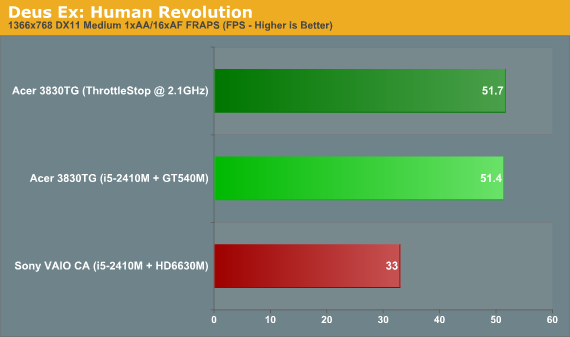
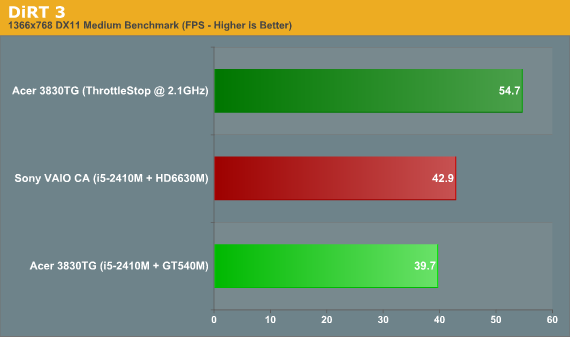
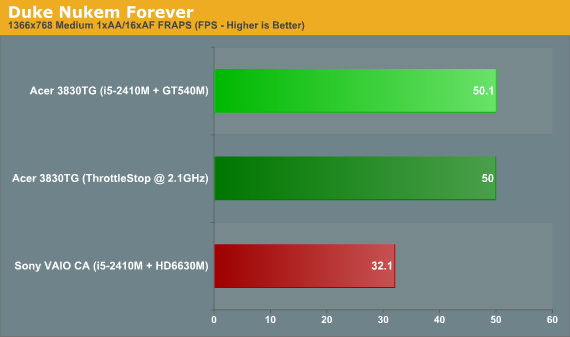
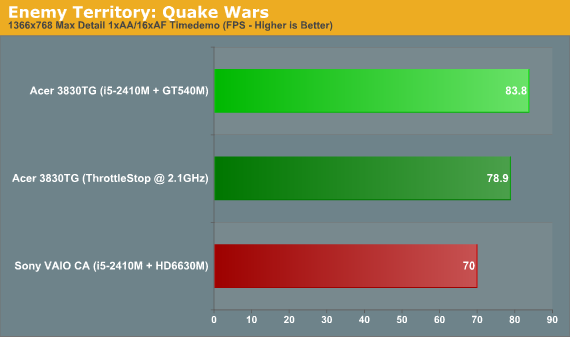
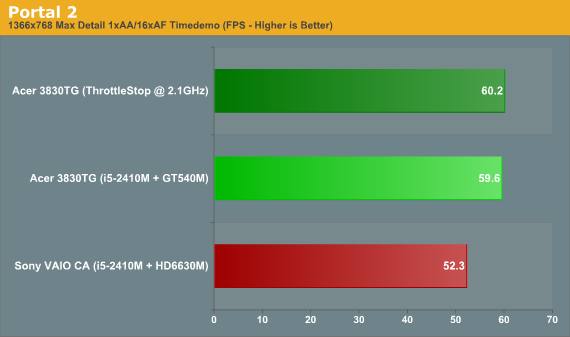
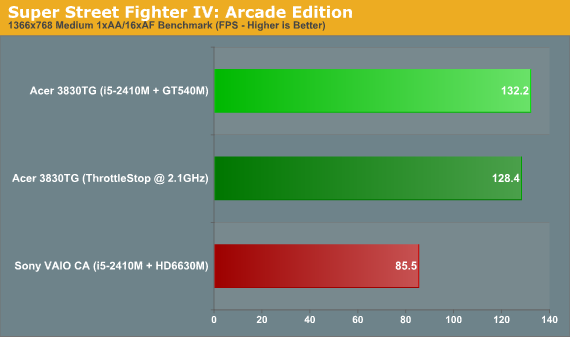
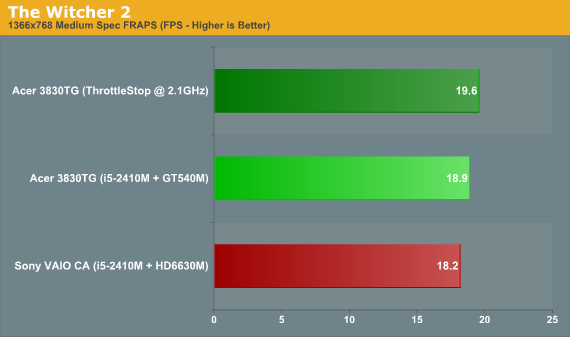
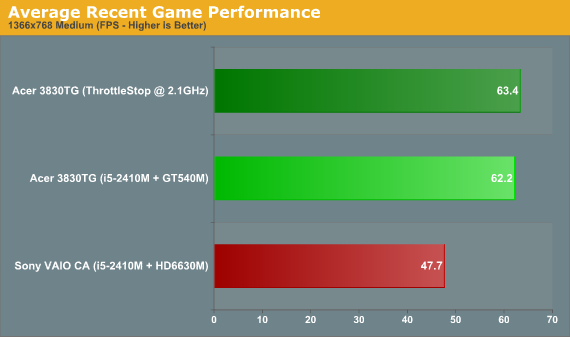
So here’s where things get interesting. In our current (soon to be deprecated) list of games on the previous page, the 6630M in the VAIO C generally equals the GT 540M in the Acer 3830TG. NVIDIA wins in Bad Company 2, Left 4 Dead 2, Mafia II, Mass Effect 2, and STALKER: Call of Pripyat by 4-14%; AMD counters by claiming wins in Civilization V (3%), DiRT 2 (1%), Metro 2033 (6%), StarCraft II (31%), and Total War: Shogun 2 (6%). Obviously, StarCraft II is the big difference, and it looks like the CPU throttling (or using ThrottleStop to set the CPU speed to 2.1GHz) accounts for a large portion of the difference. As we mentioned on the previous page, the Alienware M11x R3 averages out to 3.5% faster than the best the Acer can muster, and the Dell XPS 15 comes in 9% faster than the 3830TG, so if the CPU throttling weren’t present we’d expect the 3830TG to end up around 6% faster than the VAIO CA. Be that as it may, let’s just call it a tie between the GT 540M and HD 6630M and move on to our newer titles.
Looking at the recent releases (along with the OpenGL Enemy Territory: Quake Wars), the tables shift dramatically. The closest the VAIO C/HD 6630M gets is in The Witcher 2, where the Acer 3830TG/GT 540M still has an 8% lead. Elsewhere, NVIDIA leads by over 50% in Deus Ex: Human Revolution, Duke Nukem Forever, and Super Street Fighter IV: Arcade Edition. Rounding things out, DiRT 3 is 28% faster, ETQW is a 20% lead, and Portal 2 is 15% faster. Also worth pointing out is that three of the games in this list (DiRT 3, Deus Ex, and Portal 2) are promoted by AMD (and SSF4 is promoted by NVIDIA). Overall, in our recent titles the Acer leads the Sony by a not-insignificant 35% on average—and that’s with an Optimus laptop that we’re either running at a slower CPU speed, or potentially getting some CPU throttling. How much of the performance loss is caused by unoptimized drivers is unclear, but we suspect the 6630M with Catalyst 11.8 would fare a lot better.










91 Comments
View All Comments
fynamo - Wednesday, September 21, 2011 - link
Tried all of the driver tweaks, forced browsers hw accel, all to no avail. Firefox and Chrome both will use only IGP despite forcing them in NVIDIA control panel.In reality, most people aren't going to notice CSS3 sluggishness because very few sites actually employ CSS3 currently. But as a developer of bleeding-edge apps that are indeed using CSS3, and which we are also developing for mobile, I am HIGHLY sensitive to performance.
As stated - on Optimus, css3 performance sucks. On AMD, css3 performance is orders of magnitude better.
The other issue is with resizing and dragging windows. I noticed that the "SYSTEM" process in Task Manager (Windows 7 64) spikes to use a single full CPU core while resizing or dragging a window, and the drag / move animation slows to ~10 FPS or less. I did NOT have this problem on my "old" Radeon 3670 machine.
The same tests on a desktop, also with Windows 7 64 and with a Radeon 6850 (no IGP), show liquid-smooth and no CPU spike.
I've tested multiple Optimus systems and all have this problem, but my tests with AMD systems have yielded good results each time.
Spazweasel - Tuesday, September 20, 2011 - link
When people ask why I stick with nVidia graphics cards, this article sums up all my reasons well:1. nVidia for many years has done a much better job of delivering timely driver updates, better driver stability, and multi-GPU scaling. SLI "just works". Crossfire is a crapshoot.
2. I have never had a problem with a game that was related to an nVidia driver. I cannot say the same of AMD.
3. AMD certainly has somewhat faster hardware at a given price point, but that doesn't matter if the games crash, if the driver UI sucks, or they can't get their partners to deliver what few driver updates there are.
4. I have many friends and acquaintances in the gaming industry. Without exception, they have reported that nVidia is much, much easier to deal with and is more responsive to the concerns of game developers than AMD. nVidia will often give you some of their own engineer-time to help you work through a problem, while AMD's response is "RTFM, go away, stop bothering us". This is likely why games have fewer driver-related issues upon initial release with nVidia than AMD; nVidia will help you before your game is on the market (and include the necessary changes to their drivers in advance of the game's release), while AMD is unresponsive during development, and often well into retail.
Secondarily, never buy a Sony computing product. You'd better be happy with the drivers that come with it, because you're not going to see new ones. Over the years I've had two laptops made by Sony, and both were orphaned within 18 months of purchase (driver updates on OSs which were current when the product was new stopped, and newer OSs never got a driver at all). Sony is terrible at ongoing driver support, regardless of what the hardware category (video, audio, input device, peripheral connection hardware) is. I've come to the conclusion that there is nothing software-related which Sony can get right, on either a technical nor ethical basis, and that planned obsolescence through early termination of software support is explicitly part of their business strategy.
My most recent AMD experience is a 4870, which was (and is) fast, loud, and unstable. I've thought about a 6570 for an HTPC, mostly for thermal reasons and packaging reasons (if you want a quiet, cool video card capable of moderate detail-level gaming to feed a 720p TV that is low-profile, you're pretty much limited to AMD), so it's about time for me to see if anything's changed. In the meantime, for my heavy-duty gaming machine, it's nVidia and will remain so until AMD's driver team gets its act together, regardless of how nice AMD's hardware is. Seriously, the hardware team at AMD needs to put the beat-down on the Catalyst guys; the driver team is making everyone look bad.
tecknurd - Wednesday, September 21, 2011 - link
I completely agree. ATI never wrote reliable and stable drivers. Also they gave me a run-around by saying to update to the latest drivers which I did at the time, but the graphic drivers still crashed my setup. Now AMD owns ATI and they have the same faults as ATI. People say that Radeon graphics is good, but this article shows they do not care for reliability and stability which are require for GUI.I switched to nVidia because of poor driver support from ATI. Also poor driver support in Linux for Radeon graphics. IMHO, the open source community does a better job writing drivers for Radeon graphics compared to AMD.
I would buy AMD for their CPU but not for their graphics.
chinedooo - Wednesday, September 21, 2011 - link
haha the dv6t with a 6770m would kill all these other laptops. And it switches perfectly too. I get like 6-7 hrs web browsing on mine.chinedooo - Wednesday, September 21, 2011 - link
Another difference between the two is the vram. the 6700 series uses gddr5. makes a world of difference.Hrel - Wednesday, September 21, 2011 - link
"and the user can add their own custom apps". Does this mean we can pick and choose if the dgpu is on or off on a per app basis? I spoke to Nvidia and they said you CAN do that in the Nvidia control panel. I just don't know how. I have the Clevo P151HM laptop, so maybe the option isn't even there on mine. I'd still like you guys to tell us how to do this, assuming it's possible.Side note, I'm annoyed this laptop only accepts drivers from Clevo, and not from Nvidia.
tanjo - Wednesday, September 21, 2011 - link
3 years and it's still not working properly???The best solution is to add ultra low power 2D power state on dGPUs.
orangpelupa - Wednesday, September 21, 2011 - link
actually you can install GENERIC driver from ATi to update the laptop with switchable graphic.just dont use the auto detect app from ATi. it useless. always decline to download the driver....
i have been long time using Acer with Intel + Radeon HD 5650. i can always update the ATi driver using generic from ati website.
for acer i just install the 11-8_mobility_vista_win7_64_dd_ccc.exe
but if the installer decline to install, you can update while using modded inf
http://game.bramantya.org/modded-inf-ati-mobility-... (sorry have not uploaded the 11.8 modded inf)
if still failed, can update manually from device manager.
just make sure before doing any update with "generic" driver is graphic switched to dGPU mode from the shortcut in right click menu in desktop.
that updating generic, work old laptop with "screen flicker when switch graphic". so i dont know if its work with the new dynamic switching ATi.
Anyone with this new DYNAMIC switching want to try?
my2cents - Wednesday, September 21, 2011 - link
Just my 2 cents. I was searching around web and found site, some blog, where some dude is creating ATI + Intel switchable graphics. I own myself a Vaio VPC-SA2S9R. Just google "leshcat_dot_blogspot_dot_com". Works good so far.RenderB - Wednesday, September 21, 2011 - link
Sadly the nvidia tool isn't doing much better. Have the same optimus config as tested, but from asus. The auto detect will always tell me to go get drivers from clearcube.